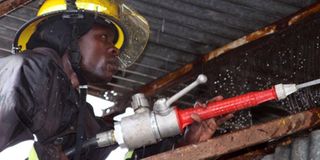Prime
Why a fire drill is a must for your home

The shrill sound of an alarm interrupted my train of thought and distracted me from the task I was concentrating on. At first, I thought that someone somewhere in the building had accidentally triggered off the alarm or even set it off to pull off a Monday morning prank.
Being just a client at this place, I was at a loss at what to do next as the people who work there seemed reluctant to leave their desks or work stations. Security officers herded us out of the building into the courtyard for the drill as the whole place was put on lockdown. There were gripes about how the fire alarms kept going off and why they should be subjected to fire drills, as security officers emphasised that it was very necessary.
At the website, answers.com, a fire drill is explained thus: “...a method of practising the evacuation of a building for a fire or other emergency. Generally, the emergency system (usually an alarm) is activated and the building is evacuated as though a real fire had occurred.
Usually, the time it takes to evacuate is measured to ensure that it occurs within a reasonable length of time, and problems with the emergency system or evacuation procedures are identified to be remedied.”
Prior to this experience, I had never undergone a fire drill or, in this case, been caught up in one. But with the frequent reports of fire outbreaks in schools, business premises, markets and homes, knowing what to do in case of a fire is not only necessary but very important. It could save a life or lives.
Frequent fires
Statistics from the Uganda Police Fire Brigade show that in January alone, there were 70 cases of fire reported in the Kampala city area and neighbouring districts. By the middle of the following month, there were 44 cases and five people injured.
Basing on such figures, it is safe to guesstimate that by the end of March, there have been about 100 cases countrywide, both reported and unreported. In an earlier interview with Daily Monitor, the Training Officer at Fire Brigade Headquarters, Stephen Engwedu pointed out, “...fires in homes are caused due to negligence. They are usually caused by candles, short circuits, poorly maintained appliance, unattended to charcoal stoves, and a few arson cases.”
In some countries, fire drills in different types of places are governed by set laws, statutes or regulations. In the US, it is a requirement that fire drills are conducted at certain intervals though this varies from state to state.
For instance, in some states, schools are obliged to carry out these drills once a month, others stipulate that there should be a greater frequency at the start of the school year, and in others, they should include a security drill.
In UK, the Fire Precautions (Workplaces) Regulations say that all workplaces must have an emergency plan consisting of staff actions, evacuation plans and arrangements for contacting the fire brigade.
But these are countries with well developed fire and emergency response structures and systems. In Uganda, while there is a police department to cater for such emergencies, there are a number of challenges that hinder efficient response mechanisms.
There are only eight towns in the country outside the capital city that have fire stations; these are Arua, Gulu, Mbale, Tororo, Jinja, Masaka, Fort Portal and Hoima. To fill the gap, there are a number of companies that sell and service equipment like fire extinguishers, fire alarms and smoke detectors. But this capacity is inadequate in face of the frequency of fire outbreaks.
One of the measures that the police have initiated is to set up a sensitisation team to educate people about protection against fires. But as Engwedu acknowledges, there are bottlenecks with such an approach. It centres on the attitude and mindset. “But people have not taken safety seriously”, he said.
Setting up a drill
Considering that 50 per cent of people who die in home fires were trying to escape when they died and that a fire can engulf a house with a few minutes from the time it started, it is only prudent that a home owner in Uganda should craft a fire drill for his or her home in case of such an emergency.
Here are general pointers on how one can do this. These cover pre-planning, an initial inspection of the home, developing a checklist, formulating a drill and the factors unique to the home that should be taken into account.
In the pre-planning stage, one should think about how the escape will be made from every room in the house, starting with the bedrooms. It is advised that the two escape routes, the second may be through a window. A decision should be made on where to assemble everyone outside once the escape has been made.
In addition, define everyone’s role and allocate responsibility.
A checklist includes questions which can be developed after the home owner has performed an inspection all over the house. Though not set in stone, some questions are on safety, obstacles and potential triggers of fires: “Does a grown-up always stay in the kitchen when food is cooking on the stove?” “Are pot handles turned inward so they cannot be bumped?” “Are extension cords used safely?” “Are electrical cords in good condition, without cracks or frayed areas?” “Is there clutter in corridors and other access points?”
What to consider
The first step in formulating a fire drill is a meeting with members of the household. “Hold a family meeting and discuss various ways on how you can evacuate your home safely and promptly in the event of a fire,” advises wikihow.com in its seven steps on to conduct a home fire drill.
Factors are particular to your home are vital to consider in the drill. For example, are there young children, people with disabilities or frequent visitors, times when it is a full house or is the home mostly empty?
How regularly to carry out the drill is dependent on the nature of the home but as the University of Wisconsin-Milwaukee (UW), US, points out in its general guidelines and policy: “Proper drills ensure orderly exit under control and prevent the panic that has been responsible for much of the loss of life in the major fire disasters of history.”
In the same vein, there should a record of all drills conducted as well as a critique. In the case of the fire drill that I was part of, I hope it was noted that there was reluctance in the participation. This is a potential pitfall that a home owner should take note of.
In the UW guidelines, this is also noted: “If a fire exit drill is considered merely as a routine exercise....there is a grave danger that in an actual fire, the drill will fail in its intended purpose.” Worth noting is that drills should be pre-planned and pre-announced so as not to breed apprehension and cause passivity to future alarms.
A review of the exercise conducted at home with all participants is vital. It helps the persons responsible to take note of the loop holes, pitfalls and areas for improvement.
In this regard, it would be only prudent that any home owner who develops a fire drill on his or her initiative to make use of the technical personnel and resources. In Uganda, the police and private service providers would be helpful.
We should be mindful of the fact that whether it is a mansion in suburbs of Kampala, a three-bedroomed house in Kasese or a manyatta in Nakapiririt, there are always resources available in the vicinity that can be used to warn of a fire or put out one. These can be a smoke detector, a whistle or a horn, a fire extinguisher, water or sand.




